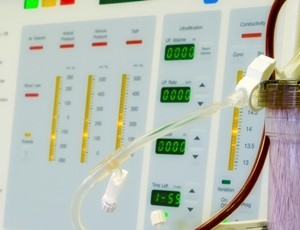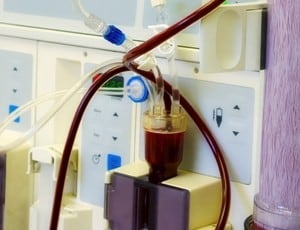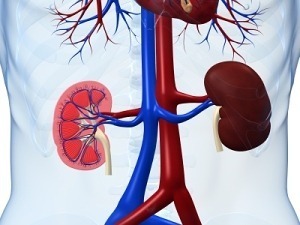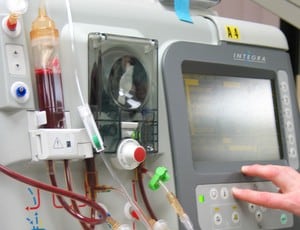Optimal hemodialysis catheter insertion can be done with no x-ray

The use of a dual vector positioning system in this study demonstrated optimal hemodialysis catheter insertion can be done with no X-ray and no increase in mechanical complications” Ramirez et al (2018). Abstract: Acute care hemodialysis catheters have traditionally been validated for use through chest X-ray interpretation. This study was implemented to evaluate if hemodialysis […]
Treatment status and medical costs for hemodialysis vascular access

This study investigated the current status of treatment and medical expenses for vascular access in Korean patients on hemodialysis” Lee et al (2018). Abstract: BACKGROUND/AIMS: The Republic of Korea is a country where the hemodialysis population is growing rapidly. It is believed that the numbers of treatments related to vascular access-related complications are also increasing. […]
Patient-specific treatment recommendations in guidelines for hemodialysis vascular access

Our findings show that current clinical practice guidelines for hemodialysis vascular access lack patient-specific recommendations” Queeley et al (2018). Abstract: BACKGROUND: Hemodialysis is a procedure that requires efficient removal and return of blood to a patient’s body. Despite being a life-sustaining process, hemodialysis is associated with morbidity, mortality, and high societal costs. A significant part […]
Central venous occlusive disease in patients with end-stage renal disease

Central venous occlusive disease is frequently observed in patients with end-stage renal disease” McFall and Lu (2018). Abstract: Central venous occlusive disease is frequently observed in patients with end-stage renal disease. Venography remains the gold standard for diagnosis, but intravascular ultrasound is a potentially beneficial adjunct that may positively influence intervention. You may also be […]
Predictors of tunneled hemodialysis catheter infection or dysfunction

To assess the ability of various clinical factors to predict infection or dysfunction of tunneled hemodialysis catheters” Coker et al (2018). Abstract: PURPOSE: To assess the ability of various clinical factors to predict infection or dysfunction of tunneled hemodialysis catheters. METHODS: A retrospective review of all adult patients who had a tunneled hemodialysis catheter placed […]
Impact of health insurance in the early stages of hemodialysis and vascular access

Patients without Medicare who develop ESKD in the United States become Medicare eligible by their fourth dialysis month. Patients without insurance may experience delays in obtaining arteriovenous fistulas or grafts before obtaining Medicare coverage” Lin et al (2018)”. Abstract: BACKGROUND AND OBJECTIVES: Patients without Medicare who develop ESKD in the United States become Medicare eligible […]
Functional review of precurved non-tunnelled catheters for haemodialysis

Our objective was to assess whether precurved non-tunnelled central venous catheters are comparable to tunnelled central venous catheters in terms of infection and catheter malfunction and to assess whether precurved non-tunnelled catheters are superior to straight catheters” van Oevelen et al (2018). Abstract: BACKGROUND: The main limitations of central venous catheters for haemodialysis access are […]
Hemodialysis using the Cardio-Renal Pediatric Dialysis Emergency Machine

We report the first worldwide experience with continuous veno-venous hemodialysis (CVVHD) in children using the last generation Cardio-Renal Pediatric Dialysis Emergency Machine (CARPEDIEM)TM device” Vidal et al (2018). Abstract: We report the first worldwide experience with continuous veno-venous hemodialysis (CVVHD) in children using the last generation Cardio-Renal Pediatric Dialysis Emergency Machine (CARPEDIEM)TM device. Thirteen children […]
Current status of dialysis and vascular access in Taiwan

However, the statistics and vascular access monitoring are relatively insufficient in the past. The comprehensive integration of vascular access management into public policy related to kidney disease will complete the missing piece of the puzzle of overall care” Chen et al (2018), Abstract: Due to the implementation of the National Health Insurance system in 1995, […]
Regulatory considerations for central venous catheters for hemodialysis

Central venous catheters remain a vital option for access for patients receiving maintenance hemodialysis. There are many important and evolving clinical and regulatory considerations for all stakeholders for these devices” Silverstein et al (2018). Abstract: Central venous catheters remain a vital option for access for patients receiving maintenance hemodialysis. There are many important and evolving […]
Complications associated with vascular access for hemodialysis in the United States

This study examines the utilization and outcomes of vascular access for long-term hemodialysis in the United States and describes the impact of temporizing catheter use on outcomes” Arhuidese et al (2018). Abstract: BACKGROUND: This study examines the utilization and outcomes of vascular access for long-term hemodialysis in the United States and describes the impact of […]
Hemodialysis central venous catheter malposition into the chest

In this report, we describe the case of a 77-year-old patient on chronic hemodialysis via catheter due to arteriovenous fistula dysfunction. We placed a cuffed-tunneled hemodialysis catheter in the left internal jugular vein. Malpositioning of the catheter led to perforation of the great veins and migration of the catheter tip into the chest” Xie et […]
CLABSI rates associated with hemodialysis patients

Our goal was to compare relative bloodstream infection rates of patients with and without catheters as a quality parameter among the facilities providing hemodialysis” Brown et al (2018). Abstract: BACKGROUND AND OBJECTIVES: Bloodstream infection rates of patients on hemodialysis with catheters are greater than with other vascular accesses and are an important quality measure. Our […]
Effect of serum vancomycin concentration on hemodialysis patient morbidity and mortality

The primary objective of this study was to determine if vancomycin serum concentrations were associated with positive outcomes in HD patients with Gram-positive bacteremia” Rambaran et al (2018). Abstract: Vascular access infection is one of the major contributors to hemodialysis (HD) patient morbidity and mortality. There is a paucity of consensus guidelines on vancomycin use […]
Vascular access thrombosis contributory factors in hemodialysis patients

The aim of this study was to assess von Willebrand factor (VWF), and a disintegrin and metalloproteinase with eight thrombospondin-type 1 motif (ADAMTS13) levels in HD patients and their association with vascular access thrombosis (VAT)” Elzorkany et al (2018). Abstract: Vascular access complications are major issues in hemodialysis (HD) patients, which increase their morbidity and […]
Technique for placement of tunneled cuffed central venous catheter

We retrospectively compared the Micropuncture kit with the standard 18-gauge Angiocath IV catheter for tunneled cuffed catheter insertion in the right jugular vein” Lee et al (2018). Abstract: Introduction: Tunneled cuffed catheters provide stable, instantaneous, long-term intravenous access for hemodialysis. Because catheterization is often performed in emergency situations, speed and accuracy are emphasized. Methods: We […]
Difficult vascular access solution in a patient on chronic hemodialysis

atients with central venous catheters (CVCs) are prone for recurrent infections, vascular thrombosis, and vascular stenosis, which contribute to significant morbidity and mortality. We present a case of a 31-year-old male who had a transhepatic hemodialysis catheter lasting for 4.5 years” Kumar et al (2018). Extract: Long-term chronic hemodialysis in patients with end-stage renal failure […]
Geriatric hemodialysis patient survival factors described

The present study revealed that comorbidities and low performance status at the onset of dialysis had shortened the survival time in the geriatric hemodialysis patient group” Tuğcu et al (2018). Abstract: INTRODUCTION: The number of geriatric patients is increasing in hemodialysis population over the years and mortality is higher in this group of patients. This […]
Vascular access device placement in elderly hemodialysis patients

Among incident hemodialysis patients ≥80 years of age, placement of an AVF from a CVC within the first year of dialysis had similar mortality compared with initial AVF use. Our data suggest that initial CVC use with later placement of an AVF may be an acceptable option among elderly hemodialysis patients” Ko et al(2018). Abstract: BACKGROUND: […]
Assisted tunneled cuffed central catheter placement

We developed a new device to support accurate placement of the tunneled cuffed catheter. In this study, we report our first clinical experience of the device” Ohara et al (2018). Abstract: Introduction: The tunneled cuffed catheter is used in hemodialysis patients for whom an arteriovenous fistula or arteriovenous graft is not suitable or for bridging […]
Children undergoing hemodialysis – Iranian mothers’ experiences

Nurses are the healthcare team members who most frequently interact with mothers of children undergoing hemodialysis. They are therefore positioned favorably to provide the information and emotional support needed by these mothers” Pourghaznein et al (2018). Abstract: Purpose: To describe Iranian mothers’ perspectives regarding hemodialysis for their children. Design and Methods: This qualitative study was […]
Dialysis surveillance scheme is associated with reductions in blood stream infection and antimicrobial consumption

“Embedding dialysis surveillance scheme is associated with reductions in blood stream infection and antimicrobial consumption” Badawy et al (2014).

